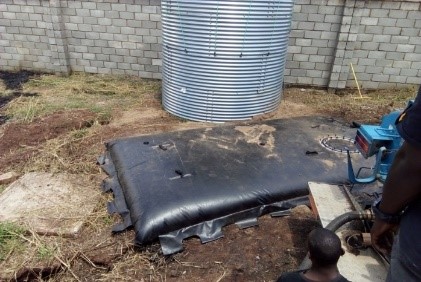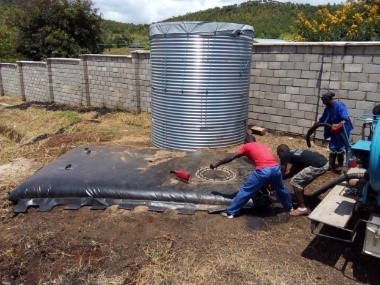FACT Sheets
Fact Sheet Faecal Sludge Metal Reservoir
Fact Sheet Faecal Sludge Reservoir Bladder
ESP Phase 2 Work


Background
As an outcome of the work done in ESP Phase 1 and experiences in several emergency responses, the need to have a reservoir specifically designed to store faecal sludge has been repeatedly identified. Reservoirs currently available on the market are not always suitable for sludge storage, as sludge from pit latrines is often mixed with different kinds of solids such as stones, leaves bottles etc. Previous experiences with sludge in commonly used reservoirs showed that outlets are easily blocked, reservoirs are difficult to clean and solids in the reservoirs can easily damage the liner. While work was also carried out to identify options to reduce the amount of solids entering a reservoir (see Sludge Screen), development of reservoirs that, amongst other criteria, are strong, puncture resistant, easy to transport and construct, easy to clean and control odours and insects remained a gap that needed to be addressed.
Work carried out in Phase 2
The Netherlands Red Cross established design criteria for sludge tanks after consultation with a number of experts and a literature review. Important criteria included:
- smell and insect control,
- durability and puncture resistance of material,
- possibility to transport (by air),
- ease of and access for cleaning
- ease and speed of set up,
- and large outlet to prevent blockages.
An international market study was conducted with several international suppliers of reservoirs and suppliers known to the emergency world contacted to discuss design criteria for the sludge reservoir. The study included a small research in advantages and disadvantages of the different liner materials. Suppliers were then invited to come forward with ideas and proposals. The results were then shared and evaluated with the assistance of an external consultant and innovator in the sanitation sector.
Rather than simply select one option, a design workshop with a few selected suppliers was organised to discuss the requirements, proposed design and possible innovations. After that workshop a small selection of equipment was purchased for testing in Malawi. The trial tested a one metal reservoir and one sludge bladder. The reservoirs were tested in conjunction with the sludge screen. The field trial was conducted by WASTE in Malawi using real faecal sludge.
Two different sludge reservoirs were developed and tested in Malawi. One of the reservoirs was similar to the well known Oxfam tank, but, amongst other differences, this tank has an outlet at the bottom of the tank. The other reservoir tested was similar to a common bladder. The sludge bladder is made of a material that is selected on the bases of durability, flexibility and resistance against tearing and punctures. To prevent the inlet or outlet to get blocked, a 6-inch outlet was fitted, while a 500mm manhole opening was fitted on the top of the bladder to facilitate cleaning. Sleeves were fitted for easy handling and support emptying and cleaning. One outlet was fitted on the corner of the bladder so remaining liquids can more easily be drained from the bladder. The bladder was delivered in a small size (5m3) for testing purposes. The product was tested in Malawi by WASTE Foundation and WES.
Results
Bladders do have the advantage to be easily transportable and quick and easy to set up, but they are difficult to clean and vulnerable for leakages. When solids are entering the bladder they can be extremely difficult to get out and increasing the risk of punctures during transport. The large 6 inch opening of the bladder worked well with the sludge used. No blockages were observed during the testing. The manhole is useful for cleaning of the bladder before transport or packing. The bladder is easy to transport and set up, so has the capacity to be deployed rapidly. It is easy to fill and empty with the correct couplings. As the bladder is a closed reservoir even if the sludge stays for a long period in the bladder, there was no offensive smell or attraction of insects. The bladder is vulnerable to damages due to vandalism or during transport and must therefore be carefully overseen and monitored. The bladder must be placed in a flat terrain without stones or sharp objects that can damage it. Small leakages or damages are easy to fix with a repair kit or superglue. Sleeves are useful to manually drain remaining sludge or liquid towards outlet.
Outlet of tank Top view of roofing
First level of metal sheets filled with sand Liner after use
As the corrugated steel tank was delivered without a manual, the initial installation was slightly difficult. After understanding the principles of the construction and the labelling of the metal sheets, construction was easy and can be completed within a day by a team of 4 to 6 people. Dismantling and reinstallation is possible, but the reservoir is most suitable for longer use in one location. No problems with the liners and roof were observed during the testing. The metal roof was not used during the test. The roof did close well enough to prevent smell and prevent easy access by flies. The 160mm bottom outlet did function well which does facilitate safe and easy cleaning. A mesh to protect the outlet was not delivered as discussed with the supplier, but it is advisable to add this option and install a bottom wall outlet as backup to prevent the outlet from getting blocked.
Next steps.
It is envisioned that WASTE will be able to use both reservoirs over a longer period in its programming in Malawi, so more results on the durability of the reservoirs will be known. Results will continue to be shared with the sector.